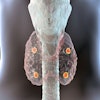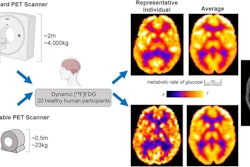PET imaging shows high levels of brain protein activity associated with injury in a large group of young, former National Football League (NFL) players, according to a study published October 30 in JAMA Network Open.
A team led by researchers at Johns Hopkins University in Baltimore, MD, found that translocator protein (TSPO) levels on PET brain scans were higher in young, former NFL players compared with elite, non-collision sport athletes, and they called for further research to find out whether these signs persist over time.
“Further understanding of the microglial response to repeated [mild traumatic brain injury] in collision sport promises to inform future guidelines for game safety and clinical practices to promote brain healing,” wrote lead author Leah Rubin, PhD, and colleagues.
TSPO is a key protein involved in neuroinflammation. Prior research has shown that after brain injuries, TSPO expression is highly increased. PET imaging with a specific radiotracer that visualizes this activity has revealed high levels across the brains of both elderly former NFL players and younger, active, or former NFL players.
However, these studies were small in size, with just nine to 10 former players, the researchers noted. To further elucidate this pathology, the group used TSPO-PET in a larger, cross-sectional study.
The group gathered data from 27 former NFL players within 12 years of their last participation in the NFL and 27 former elite, non-collision sport athletes (all swimmers) from across the U.S. Participants underwent TSPO-PET using carbon-11 DPA-713 radiotracer between April 2018 and February 2023.
 Mean parametric maps of carbon-11 (C-11) DPA-713 radiotracer binding (VT) are presented in three views for each group (NFL, control) within each TSPO genotype (C/C, C/T). VT indicates total distribution volume and is in units of milliliters per cubic centimeter (mL/cm3). Image courtesy of JAMA Network Open.
Mean parametric maps of carbon-11 (C-11) DPA-713 radiotracer binding (VT) are presented in three views for each group (NFL, control) within each TSPO genotype (C/C, C/T). VT indicates total distribution volume and is in units of milliliters per cubic centimeter (mL/cm3). Image courtesy of JAMA Network Open.
According to the findings, the magnitude of the group differences depended on brain region, with largest differences in total TSPO distribution volumes on PET seen in the cingulate and frontal cortices as well as the hippocampus.
“In this cross-sectional PET study, higher levels of TSPO that mark brain injury and repair were found in former NFL players compared with former non-collision sport athletes,” the researchers wrote.
Ultimately, TSPO is a marker of both brain injury and repair, the authors noted. This means that it is possible the findings may reflect an ongoing reparative process that will resolve in former athletes with more time away from repeated brain injury, they wrote.
“Longitudinal tracking of both TSPO and neuropsychological performance in former NFL players may inform whether neuroimmune therapy to promote brain healing is warranted,” the group concluded.
The full article is available here.




















